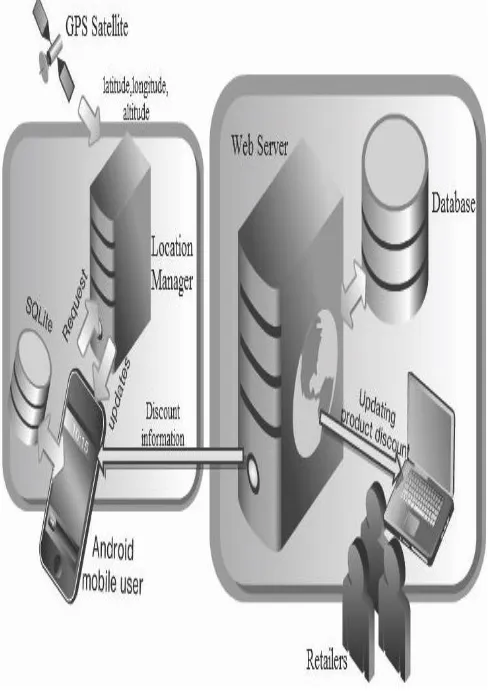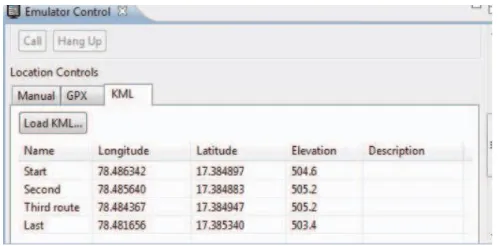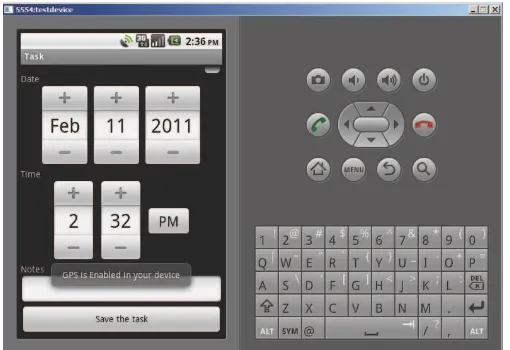24 hours GPS Tracking in Android Operating System
Rasool.R
*,Sabarinathan.K
*,Suresh.M
*,Syed Salmon.H
*, Ragavan
***
Department of Information Technology, SKP Engineering college **
AP/Department of Information Technology, SKP Engineering college
Abstract- In this paper, I present a Smartphone-based autonomous management of Location. When developing a location-aware application for Android, one can utilize GPS and Android's Network Location Provider to acquire the user location. Android's Network Location Provider determines user location using cell tower and Wi-Fi signals, providing location information in a way that works indoors and outdoors, responds faster, and uses less battery power. To obtain the user location in your application, one can use both GPS and the Network Location Provider, or just one. Here one could track the positions of the Android Device constantly for 2/4hrs and save them on a well secured webpage. So that if a device is found to be in a prohibited area it can be easily traced out. Hence it is very useful for the military purposes. No unauthorized devices can enter or leave the area without notification to the server. It can also help to create a daily log of device i.e each and every location visited by the device in a day.
Index Terms- Android Devices, Wi-Fi, Smartphone, GPS ( Global Positioning System)
I. INTRODUCTION
obile has become a vital communication tool which everyone prefers to possess and carry along. This technology has laid a foundation to overcome the traditional desktop based approach of obtaining information. Mark Weiser the father of Pervasive Computing in his paper entitled, ‘The Computers of 21st Century, ‘envisioned that, “The technology would weave into the fabric of everyday life until they are
indistinguishable from it, “this is the his vision and has come true
in this current 21stcentury. Following the vision of Mark Weiser, researchers at Carnegie Mellon University in a project Aura demonstrated that, human distractions could be minimized by Ubiquitous systems which will have to be proactive in anticipating the demands, thus self-tunable so as to give a better response to the future hassles. The ability to sense and process a context forms as a fundamental requirement for a system to be proactive. Hence, designing a context -aware application would pave way to satisfy the future growing requirements of user. Most promising type of contextual information is the proximity selection known as Location Based Service (LBS). Tracking location of a mobile device accurately has been a challenging research topic for decades. Global Positioning Systems (GPS) is a top priority technology used for locating a device position accurately. Methodology for tracking can be done using a GPS receiver which is an additional hardware integrated in most of mobile equipment. We have used GPS as the approach idea for location tracking. The platform used for development is Android Operating System, as described [6] is
been proven as the best operating system for a context-aware location based services. Customer friendly user interface letting user to enter the task and store it for future retrieval is done using the exclusive SQLite inbuilt database available in Android mobile. User can align task associated with any location and retrieving details as alert before reaching a desired location of interest. User entering into this application is given an option for connecting to the database so as to verify the location updates. Information is then delivered at the right time in the right place to the right person. The mobile user will also be able to receive retail offers and discount information in the surrounding by this intelligent observer module.
This paper is organized as follows: Section II discusses on various literatures reviewed. Section III provides an overview of the proposed solution and design model. Section IV describes about implementation and Section V focuses on the outcome Section VI concludes the paper. Future enhancement of this project is also discussed at the end.
II. LITERATURE REVIEW
Literatures on the prior research work done by accredited scholars in the Ubiquitous Computing domain are reviewed. Challenges and solutions proposed are in specific to context aware location based service are presented here.
Zohaib et al[6] has put forth the major challenges faced in designing a ubiquitous application. Android operating system is suggested as a best tool for designing context aware applications. Towards the end, author had featured an analysis report on performance of various mobile devices for a location aware computing.
Xianhua et al in their manuscript [8] have described on the anatomy of Android architecture. Components of Android platform such as Activity, Services, Content Providers and Broadcast Receivers were introduced thus providing a better insight of application development.
Sandeep et al[5] have outlined the significance of location based services. Technological development in an exponential manner have paved a way to access hardware directly by customized application interface such as GPS, web service, programming cameras were elucidated.
Ubiquitous Computing is an emerging technology and has lot of challenges in design, modelling and user interaction which are identified and implemented in this organizer application .
III. PROPOSED SOLUTION
Providing continuous and uninterrupted service is essential for tracking mobile location without affecting the regular
routines of any user. This organizer application would ease user to track current location, compare it with the task and displays discount information, thus acting as an intelligent observer of the surrounding.
A. Architecture
Task is entered and stored in the SQLite database. Location tracking is performed using the GPS service. Changes in location can be emulated with the help of (Key Hole Markup language) KML file in Android. The location change is compared with the database entries to see if there are tasks associated to the current location. Corresponding task information is displayed on the mobile screen. Web server is invoked whenever change in location is sensed and is used for displaying retail discount information. Fig 1 shows the architecture of location module designed for tracking and retrieving the information based on location to the user.
Figure 1.Architecture Diagram
B. Design
[image:2.612.46.290.266.612.2]Designer model is developed to describe the overall layout of the project. Fig 2 illustrates in detail the basic model used as reference during the project implementation.
Figure 2. Application flow
Service will invoke the application automatically on booted. Location server constantly delivers the location information to mobile every 3 seconds. Based on this communication with the backend server for displaying corresponding task is established.
IV. IMPLEMENTATION
Location application will get the task input from user and will listen for location changes. The new co-ordinates are passed to service routine written for handling task. Following are the benefits of task application
•Adding and editing task •Storing task in SQLite database •Tracking and displaying location •Viewing retail discount information •Retrieving information on mobile device •Task around few Km displayed as alert
A. Service Invocation
service is invoked automatically using our service routine. Permission has to be set in the Android Manifest file as shown in the Fig 3.
<uses-permission android:
[image:3.612.318.567.55.178.2]name="android.permission.RECEIVE_BOOT_COMPLETED "></uses-permission>
Figure 3. Permission for Boot
B. Location Services
Application will have to register to the Broadcast Receiver which is an Android component for receiving location updates. These Permissions for location updates are registered as shown in Fig.4 in Android Manifest file.
<uses-permission android: name="android.permission. ACCESS_FINE_LOCATION"/>
Figure 4. Permission for location access
Location information is retrieved with the help of Location Manager System by invoking the command getSystemService
(Context.LOCATIONSERVICE).Code for invocation is shown in
the Fig 5.
lm = (LocationManager)
getSystemService(Context.LOCATION_SERVICE); locationListener = new MyLocationListener() lm.requestLocationUpdates(
LocationManager.GPS_PROVIDER, 0, 0, locationListener);
Figure 5. Location Manager invocation command
Applications having a Location Manager are able to do the following:
ƒ Query for the list of all Location Providers of last known location.
ƒ Register/unregister for periodic updates of the user's current location from a Location Provider.
ƒ Register/unregister for a given Intent (message) to be fired if the device comes within a given proximity of a required latitude /longitude
Location changes can be tested in the emulator using Keyhole Markup Language (KML) files that provides geographical location details. KML file is created using Google earth.The .kml file output from the Google earth is converted into android compatible format using ge2adt tool. Fig 6 shows the Droid Debug Monitor Server (DDMS) perspective in eclipse displaying the emulator control view.
Four points on the path of location of interest were chosen and loaded in the KML tab of Android emulator control.
Figure 6.Emulator control showing KML files
C. Database
Task data is stored in the SQLite database and can be viewed using special third part browser while running the program. Database entries are pulled from the device in DDMS perspective and downloaded to the user system for further analysis. Latitude, longitude, distance of interest and essential product details along with product identification code and shop name are stored in MySQL backend for shopping offers display.
D. Discount Information
Retailers wishing to publish product discount information can do so by registering into the webserver. Once done, the administrative rights of uploading discount information are given to the retailer. Request communication from mobile to the web server is done through Hyper Text Transfer Protocol (HTTP). Matched discount information corresponding to latitude and longitude will be passed back to the Android mobile using JSN format and the same will be displayed.
V. OUTCOME
[image:3.612.318.572.516.687.2]Android project for location tracking has various fields for task entry in the emulator. Fields includes task name, location details tags, date time and priority of the task. Once done user can save these task details.
Figure 1. Latitude and longitude of new location
GPS status is checked once the task is loaded into the database. Status of GPS is shown as a toast message in the emulator screen. If the status is disabled then the toast message displays the path to invoke location service. Disabled GPS status is on emulator is captured and shown in Fig 7 and the GPS enabled status is shown in Fig 8.
Figure 8.GPS enabled status shown on emulator
Intents will receive location updates constantly and will check for location changes every 3 seconds and once change in location is determined it invokes the web server and updates to the SQLite database.
Figure 9.Location changes display
Change in location is found using the service and displayed in the emulator as shown in Fig 9.On reverse geocoding corresponding location name is obtained which can be displayed on the mobile screen. Distance is calculated between the current position and that in database and if found to be less than the desired user range, then the task information is displayed back on user screen.
VI. CONCLUSION
Future battle in the telecom industry is least expected to be based on the hardware or the features like SMS and call cost, but the battle would be based on the enhanced user friendly applications provided by the service provider and adaptability for such applications provided by device manufacturers. Setting up of infrastructure for a location based service using the GPS facility, to alert a user on reaching a desired location is emulated using the Android 2.2 platform and the desired output is obtained successfully. Thus this Location based intelligent observer application using GPS tracking is developed so as to add value and organize users’ task intelligently.
VII. FUTURE WORK
Invocation of web server and retrieving the relevant discount information into a mobile device is in progress. Thus marching towards building a complete location based service .In the same way one control the other applications by means of GPS locations. It will be very useful for security purposes and to control the activities of the users in a certain area. For example inside the educational buildings and office arenas entertainment applications can be restricted to use.
REFERENCES
[1] Asim S,Daniel.S.Junichi.F and Neema M,”Sensay:A context-aware mobile phone,” Proceedings,seventh IEEE International symposium on Wearable computers,pp.248-249,2003.
[2] Bandra.U,Bandra.P,”Tagciti:A practical approach for location-aware and socially relevant information creation and discovery for mobile users,”IEEE International symposium on Wireless communication systems,Reykjavik,pp.118-122,2008.
[3] Brones T.Costa,P.D.Etter R,”A rule based approach towards context- aware user notification services,” IEEE International conference on Pervasive service,pp.281-284,2006.
[4] Fan Jiang and Saoping Ku,”How to display the data from database by Listview on Android,” second International workshop on Intelligent Systems and Applications(ISA),2010.
[5] Gupta.A.kumar,S.Qadeer,M.A.,”Location based services using android(LBSOID),” IEEE International conference on Multimedia services architecture and applications,pp 1-5,2009.
[6] Hassan,Z.S ,”Ubiquitous computing and android,” third international conference on Digital information management,pp. 166-171,2008. [7] Li Xu Dong,Tang Hai and Yan Gaoshi,”Android based wireless
location and surrounding search system design,”ninth international symposium on Distributed computing and applications to business engineering science,Hong Kong,pp.421-423,2010.
[8] Rong Chen,Xianhua Shu,Zhenjun Du,”Research on mobile loctation service design based on android,”fifth international conference on Wireless communications networking and mobile computing,pp 1-4,2009. [9] Tor-Morten,Gronli Jarle,Hansen Gheorghita,Ghinea,”Android,Java ME
and Windows Mobile interplay,”IEEE 24th International Conference on Advanced information networking and applications workshop,2010.
AUTHORS
First Author - Rasool.R, B.Tech(IT), SKP engineering College, rasool10390@gmail.com.
Second Author - Sabarinathan.K, B.tech(IT), SKP Engineering College, Sabari081@gmail.com.
Third Author - Suresh.M, B.Tech(IT),SKP Engineering college, msuresh64@gmail.com .
Fourth Author - Syed Salmon.H, B.Tech(IT),SKP Engineering College,SyedSalmon@gmail.com.


